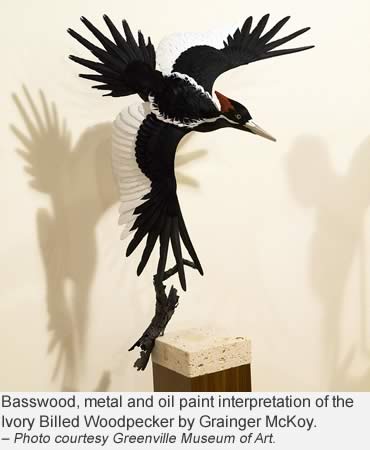Photo: Image courtesy Special Collections Toronto Public Library, Birds of America, Birds of America, John James Audubon. CC BY-SA 2.0
The ivory billed woodpecker, the historically illusive bird with a 3-foot wingspan and memorable nickname, may or may not be extinct. However, the verdict remains inconclusive on the status of the magnificent woodpecker called the Lord God Bird.
Its name is derived from an expression people often used to describe it when seeing it in flight: “Lord God, what a bird!”
Believed to be gone for decades, a fierce frenzy of debate in ornithological circles followed the 2021 proposal by the U.S. Fish & Wildlife Service to remove the ivory billed woodpecker from the endangered species list and declare it extinct. The final decision is expected in 2023.
Auburn University’s Dr. Geoffrey Hill, professor and curator of birds with the Department of Biological Sciences, says declaring the ivory billed woodpecker extinct is wrong. He contends the woodpecker is simply effective at eluding researchers and conservationists, and with good reason.
Following the recent Fish & Wildlife ruling, Dr. Hill said this is the third time ivory-billed woodpeckers have been declared extinct.
“Ornithologists ruled the bird extinct after ‘the last pair’ was shot in Florida in 1924. Then, a Louisiana state representative shot one in Louisiana in 1932 just to prove they were not extinct. When that small population disappeared, they were, for the second time, declared extinct until a Cornell University group filmed one in Arkansas in 2004. The recent declaration that the birds are extinct is simply the follow-up to that 2004 discovery—the end of round three. I think this cycle will continue,” he said through the Auburn Office of Communications and Marketing.
 Currently, the ivory billed woodpecker remains listed as Critically Endangered. The Fish & Wildlife Service has said the bird was gone for good because no sightings of it have been documented in roughly eight decades. That claim may or may not be true. What is true is that recording a clear image of the bird in flight has, for the most part, eluded researchers, and there are reasons for that.
Currently, the ivory billed woodpecker remains listed as Critically Endangered. The Fish & Wildlife Service has said the bird was gone for good because no sightings of it have been documented in roughly eight decades. That claim may or may not be true. What is true is that recording a clear image of the bird in flight has, for the most part, eluded researchers, and there are reasons for that.
While its final status is yet to be determined, a research group recently published its findings with a very hopeful conclusion that a small number of the birds remain alive and are well-hidden in Southeastern swamps.
Researchers Dr. Steven Latta from the National Aviary in Pittsburgh, and Mark Michaels along with research associates and community scientists have amassed trail camera images, recordings, audio recordings and drone footage of the elusive birds. The research was gathered during an intensive search in Louisiana led by Latta and Michaels for their Project Principalis.
The resulting research paper, “Multiple lines of evidence suggest the persistence of the Ivory-billed Woodpecker (Campephilus principalis) in Louisiana,” awaits approval. The group has been building a body of evidence for a decade. However, the images from the project are not the clear, close-up images critics and the public want, Michaels said.
Read more about their work here.
Dr. Hill explains that the “ivory-billed woodpecker was shot to near extinction. Habitat loss had very little to do with the decline of ivory-billed woodpeckers. There has always been extensive habitat for ivory-billed woodpeckers in the southeastern U.S. The birds were systematically hunted until all vulnerable individuals were dead. The few birds that remained were very good at staying away from people. They still are.”
Hill says he expects the woodpeckers to reappear. “Since ivory-billed woodpeckers are still flying around forests, at least in Florida and Louisiana and probably in Alabama and Mississippi as well, I would say that it is just a matter of time.
“The good news is that in my lifetime (and I’m not young), it is very rare. Nearly every endangered species of bird in the continental U.S. is recovering—becoming more common. It has become much more common to hear success stories of rare birds—bald eagles no longer endangered; Kirtland’s warblers colonizing new states; peregrine falcons returning to nest on buildings in large cities. It was irresponsible activities in the 18th and early 19th centuries that wiped out, or nearly wiped out, Bachman’s warblers and ivory-billed woodpeckers,” he explains.
The Lord God Bird has been called a “ghost of the swamps,” charismatic, and a lover of grubs. Its body is long and slender, about 18 to 20 inches, and its plumage is blue-black with red on the male’s head and white markings on the neck, back and underwing. It has a strong, straight bill and a long, barbed tongue. It uses its bill to peel bark from dead trees to search for insects.
To hear a recording of the ivory billed woodpecker, click here.
Visitors, hunters and folks who work in or frequent forested land in the Southeast may want to keep that cell phone camera handy and look up. Frequently. If you are astounded to see a very large, unusual bird in the forest sky, take a photo and record the bird’s call.
A number of ornithologists are very interested in hearing your recordings and seeing your photos of a magnificently large and rare woodpecker.
– Resources: USFWS, Auburn University Office of Communications and Marketing, The National Aviary, abcbirds.org.